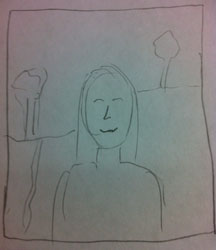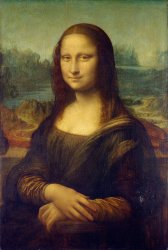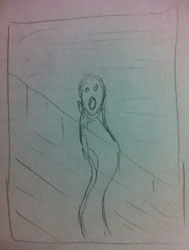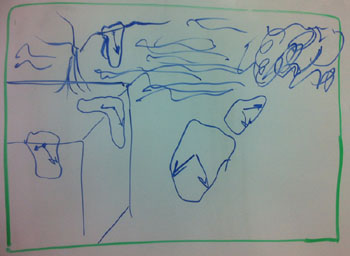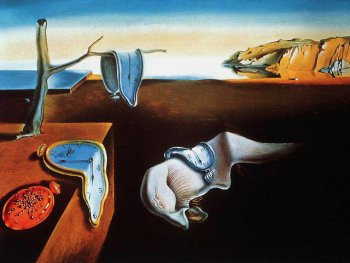Sketching Art Masterpieces from Memory
Some of my fellow engineers and I watch the show, Brain Games, on the National Geographic Channel (I highly recommend watching the show if you haven't seen it, yet). On one episode, they performed an experiment based on the study, The Science of Cycology, by Rebecca Lawson. Subjects were given a basic, incomplete layout of a bicycle, showing just part of the frame, the wheels, the seat, and the handlebars, and then asked to fill in the rest of the drawing with the pedals, chain, and completing the frame. Below is a copy of the basic layout that they were given.

This may at first appear to be a simple task, but it turns out to be surprisingly difficult for a large number of people. If you want to see what types of drawings Lawson got from the test subjects, follow that link above to read her paper (it's not terribly long, and you can jump ahead to the interesting parts, anyway). If you really want to play along, try it for yourself before following the link.
The study listed errors in frame, pedals, and chain independently, so I'm sure there was some overlap in the errors, and I'm unsure what that overlap was, but nearly half of the drawings had the chain drawn incorrectly to where the bike wouldn't work. In other words, at least around half of the drawings were wrong. If some people got the chain right but made mistakes in other parts, then the number is even higher.
The hypothesized reason is that our memories really aren't as good as we think they are. While we all know a bicycle when we see one, and think we have a good memory of just what a bicycle looks like, the truth is that many of us remember only just enough to recognize the bicycle, but not much detail.
Of course, us engineers in the office had no problem drawing a bicycle from memory. In fact, we didn't even need the skeletal layout to start off with. We could all just draw it from a blank sheet. But I didn't think this was exactly representative. For one, we're all mechanical engineers (if you count aero as a subset of mechanical), so this is exactly the type of thing we pay attention to. For another, with our bent towards mechanical design, we don't actually have to remember what the bike looks like. We can just remember a few details, and then fill in the rest as we go to make a functioning product. That's the type of thing we do on a daily basis.
So, we got to talking about another way to test Lawson's hypothesis. Was there something else that we should be familiar with, that we would recognize instantly, to try drawing from memory. And we decided that art masterpieces were the perfect objects. These are things you see repeatedly throughout your life. And we couldn't use our mechanical aptitude to fill in details. We had to rely on memory.
Before I go on, I'll list the pieces that we attempted to draw. If you want to have some fun, try drawing them for yourself before you scroll on further (or before you click on the links).
- Mona Lisa, Leonardo da Vinci
- The Scream, Edvard Munch
- The Persistence of Memory, Salvador Dalí
[Intentional blank lines to leave some space so that you don't accidentally see the real versions if you want to draw them yourself.]
.
.
.
.
How did we do? Pretty poorly, and not just on artistic merit. I don't have copies of every sketch that we did, since the other engineer who was trying it was doing his sketches on a white board and had to erase each one to have a clean canvas for the next masterpiece. But I was doing mine by pencil on scratch paper, so I at least have all of mine. Below are my sketches and one of his, followed by the real masterpiece.
The Mona Lisa
The Scream
The Persistence of Memory
We may have gotten a few of the big details right, but we really missed a lot when it came to filling it in. We both missed many details in the Mona Lisa, even something as prominent as her hands. Neither of us had the extra people or the sailboats in The Scream. And my Persistence of Memory was particularly dismal (the other engineer's was pretty good, but he admitted to having painted a copy of it in an art class).
I can think of another permutation on this, actually similar to what Lawson did in another section of her study - multiple choice. How many of us would be able to pick the correct version of a masterpiece given multiple similar choices (either through alterations, or probably even more difficult, through the time honored tradition of hand painted reproductions).
Anyway, while this post is nominally related to Rebecca Lawson's study, and our anecdotes fall in line with what she's proposing, the real reason I posted this was because it was fun. Get together with some friends and try doing this for yourself. Pick a masterpiece, try sketching it from memory, and then compare your sketches to each other and to the real thing. If you're like us, you'll be surprised at how little you can remember, but you'll have fun doing it.

